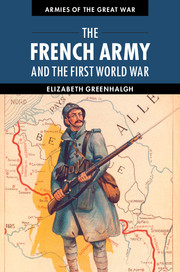Book contents
- Frontmatter
- Contents
- List of figures
- List of maps
- List of tables
- Preface
- List of abbreviations
- Introduction
- 1 The pre-war Army
- 2 1914: From the frontiers to Flanders
- 3 1915: On the offensive
- 4 1916: Verdun and the Somme
- 5 General Nivelle and his 1917 offensive
- 6 Restoring the Army
- 7 1918: German offensives
- 8 The path to victory
- 9 Armistices and demobilisation
- 10 From 1914 to 1919: Aux armes, citoyens!
- Notes
- Bibliographic essay
- Index
10 - From 1914 to 1919: Aux armes, citoyens!
Published online by Cambridge University Press: 05 November 2014
- Frontmatter
- Contents
- List of figures
- List of maps
- List of tables
- Preface
- List of abbreviations
- Introduction
- 1 The pre-war Army
- 2 1914: From the frontiers to Flanders
- 3 1915: On the offensive
- 4 1916: Verdun and the Somme
- 5 General Nivelle and his 1917 offensive
- 6 Restoring the Army
- 7 1918: German offensives
- 8 The path to victory
- 9 Armistices and demobilisation
- 10 From 1914 to 1919: Aux armes, citoyens!
- Notes
- Bibliographic essay
- Index
Summary
France’s Army through the years of war
In August 1914 Joffre’s stated intention was to take the offensive once all his armies had assembled. Despite some claims to the contrary, the French Army’s ‘doctrine of the offensive’ did not imply a belief that sufficient offensive spirit could carry a soldier in his red trousers and armed with a bayonet into the enemy’s lines, where he could pluck a laurel wreath from an enemy gun. Unfortunately, however, too many insufficiently trained men, led by unfit or incompetent commanders, attempted to mount infantry charges, unsupported by artillery and lacking intelligence about the enemy’s whereabouts and strength. Yet, fortunately, enough sense of the offensive survived the slaughter of the Battles of the Frontiers to enable the French to retreat far enough to turn around and halt the invasion on the Marne, much to German surprise. In 1915 the French Army began to think about methods, and how to break out from the static trenches and through the enemy’s front line. The thinking was mainly top-down at first, but gradually ideas began to percolate upwards as well, and by the end of 1915 GQG was soliciting detailed after-action reports in order to learn lessons. The aim remained breakthrough, but this proved elusive as the belligerents matched ever greater volumes of shell. The two Western Front battles of 1916 showed that, even when the front lines were breached, the depth of the defensive positions meant strategic failure. One answer was the ‘scientific method’, in which lengths and depths of front were assessed and the numbers of shells necessary to shatter defences were calculated, but this method was no more successful on the Somme than the enemy offensive had been at Verdun. There the Germans had concentrated an immense weight of artillery against a limited objective, but the French defenders managed to hold on. Nivelle’s successful counter-stroke at Verdun in October 1916 gave him the top job in 1917, but then his attempt to duplicate his tactical success on a strategic scale failed utterly, achieving neither surprise, nor speed, nor overwhelming superiority of firepower. His failure led men to cry ‘halt’.
- Type
- Chapter
- Information
- The French Army and the First World War , pp. 376 - 409Publisher: Cambridge University PressPrint publication year: 2014



